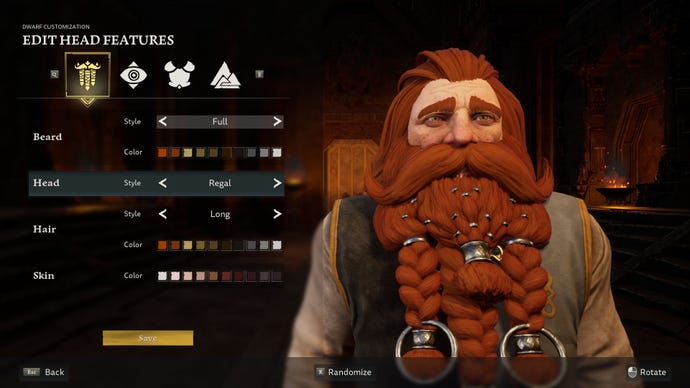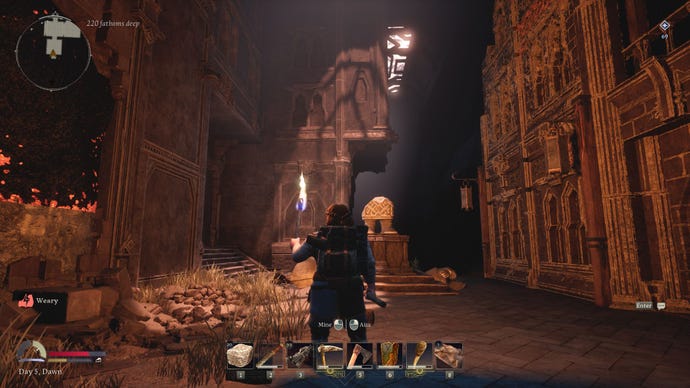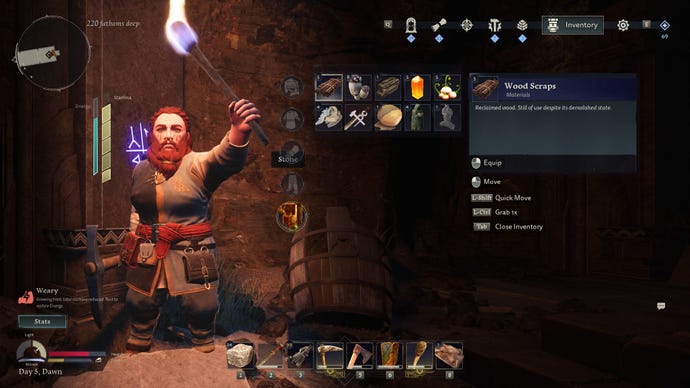I am sure an honest, self-respecting Tolkienian fantasy dwarf would, if I pinched his apple cheeks and told him he’s very endearing, he’d at best glare at me and at worst kneecap me with his axe. And yet! That’s a large part of what I enjoy about the new subterranean survival-craft-’em-up The Lord Of The Rings: Return To Moria. It’s a slower, more weighty survival game than you might be used to if you’re a Valheim or ARK type, for example, and you’ll spend a lot of your time in the dark. But what is this, a survival game for elves? No sir. And besides, like I said, it’s rather sweet. Cosy, even.
In a way Return To Moria has an easier job than it might; The Lord Of The Rings doesn’t have a great recent track record for offical game tie-ins, so, like the audience at a wedding watching the best man step up to the mic, we’re all already rootin’ for ya, champ. The framing is that, many years post-trilogy, a white-bearded Gimli (voiced, however briefly, by John Rhys-Davies) is ignoring the rule of the King and has decided to take back Moria, the deep dwarf mines that were overrun by orcs. You – and your pals, if you’re playing co-op, which I highly recommend – are trapped in a rockfall. Thus: game.
This setting allows for some genuine ‘ooh!’ reveals and properly great environmental storytelling. This used to be a legit dwarf kingdom, after all, and you’ll pick through old underground villages that have houses with the remains of bedrooms upstairs and, if you’re lucky, storerooms of wood and stone you can use. Some rooms or statues have the remains of barricades studded with arrows, indicating a desperate last stand. As a smart dwarf, you quickly figure out the best approach early on is to set up camps in the ruins of the old civilisation, repairing collapsed forges instead of building new ones. Your hearths, where you cook meals, throw a cheery light, and you can stop up gaps in walls to offer protection from the baddies coming to hit you.
Baddies include wolves (a lot of wolves, all the time), goblins, and aggressive semi-armoured badgers. Later: orcs, but pinkish daywalker types. In a perfect example of the lovely sort of jank in Return To Moria, your skirmishes are weirdly silent, but all other life forms in the mines, hostile or no, have the same patta-patta-patta footsteps. You can listen to what seems like an entire regiment of bastards tramping past your firelit walls. Enemy proximity stops you from sleeping, so it gets a bit ‘KEEP IT DOWN OUT THERE!’ at times. You see how so much of this game passively makes you roleplay as a dwarf?
Despite being the most curmugeonly of fantasy species, the dwarfs love a good sing-song when mining, and can build huge beer vats once you get the precious ores hidden in the deep mines proper, upgrading your gear as you go. You find different biomes, for want of a better word, as you tunnel deeper, and graduate from giant rat meat to sort-of-deer meat, and hit rich seams of ore, and fire up huge, ancient forge engines. I have lofty ambitions of fortifying entire halls on the upper levels, filling them with hearths and meal tables full of sizzling meat – self-sustaining dwarf homes with planters for cabbages and mint! The light of your home fires is so comforting and cheerful.

I made fun of the way press releases talked about the character creation, but it’s fabulous. You just pick different hair and ornaments, and make your dwarf body go in and out in different places if you want. Faces are described with an adjective like Regal or Elfin depending on how craggy they are.Image credit: RPS/North Beach Games
This goal is slightly out of reach without many more hours of play for me, since I’ve mostly been by myself. Return To Moria really is more fun with others, both practically – they can help you mine and craft more efficiently – and just generally with little touches. When you come across new places you’ll have a little back-and-forth chat with the other dwarfs near you, commenting on how you shouldn’t be surprised to find such-and-such a thing here, and multiple dwarfs will harmonise together as they sing. It’s lovely! By yourself it’s a bit lonely, and it’s harder to make meaningful progress since you’re not, e.g., splitting the duties of carrying food vs. carrying building materials. There isn’t online matchmaking with randoms, which makes sense because you don’t want to run into a dwarf griefer – it would genuinely ruin the ambience. But it makes it hard to find people to play with if you haven’t all agreed to get the game first.
You can see that some things were out of reach of the ambition of the devs as well. The deeper parts of the mines are impressive and foreboding, but in practise some of the buildings are blocked up where you might expect to go in and have a poke around, the enemy AI is forgiving to the point of making you feel a bit sorry for the giant bats you can one-punch to death, and though there are many status effects (wet, cold, tired, etc.) I’m unclear as to how, exactly, they impacted me while I was stomping around. Darkness is an important factor, because it’s more dangerous in dark areas so you’re encouraged to light fires and place torches as you delve deeper, but honestly a lot of the time, unless I was exploring an entirely new area, I just ran around in the dark.



The bones are good, is what I’m saying, but the flesh needs a little bit of tweaking, especially with very little annoyances. When playing with a friend, for example, there’s sometimes some confusion as the game tries to combine craft tables built by different players into the one system. When you build a hearth near existing heaps of supplies, those supplies don’t automatically become part of your useable camp inventory, meaning you have to collect them all and then put them in a supply heap you’ve made yourself. Little things! But maybe some larger things. The scale of the map is annoying, and Return To Moria doesn’t have the front-loading of a lot of easy wins to the same extent as other games of its type. Like I said: it’s slower, methodical, and sometimes the rate of progress is frustrating.
But it’s so sweet! It’s so full of love and pretty reveals, and empty dwarf pubs that feel hand crafted, and overheard orc conversations where they bitch about goblins. If you have a group of friends that you already play games like this with, then I’d say it’s well worth bringing campfires and cosy stew to as many corners of Moria as you can.
This post was originally published on this site be sure to check out more of their content.








